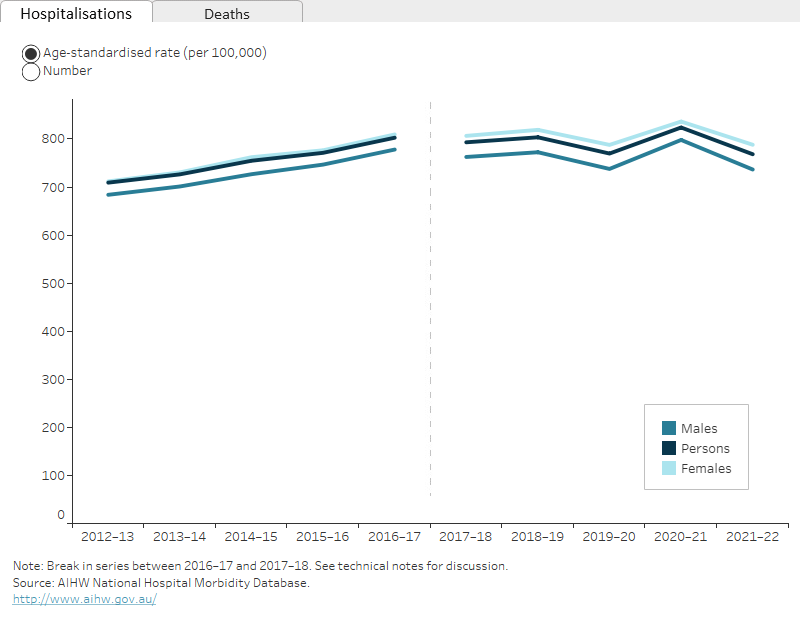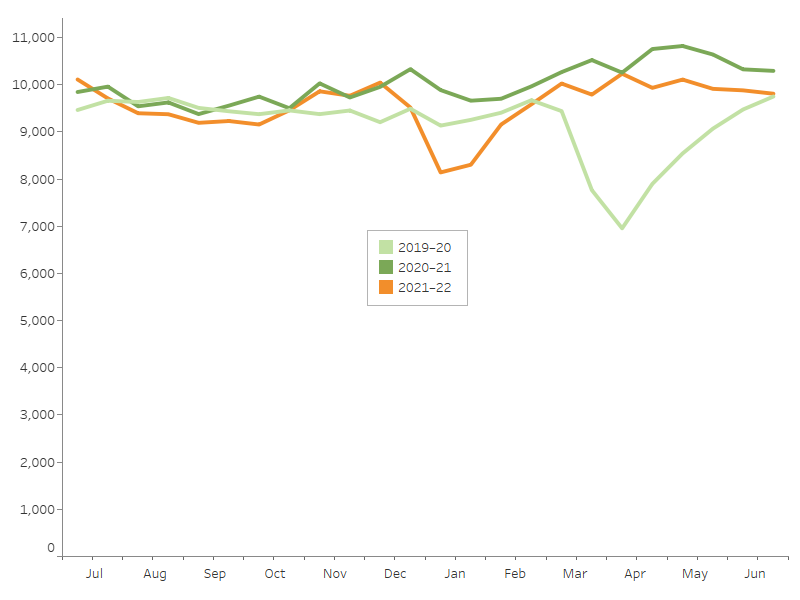For more detail, see Data tables A10 and A11.
The type of injury sustained was different for males and females hospitalised for falls. Fractures, and superficial injuries were more common for females than males. Soft tissue, open wound, intracranial, and internal organ injuries were more common for males.
There were also differences in the body part injured. Hip and lower limb injuries, and shoulder and upper limb injuries were more common for females than males. Wrist and hand injuries were more common for males.
Among Aboriginal and Torres Strait Islander people, injuries caused by falls led to:
- 7,500 hospitalisations in 2021–22 (Table 5)
- 54 deaths in 2020–21 (Table 6)
Rates of hospitalisation for injuries caused by falls were highest among people aged 65 and over (Figure 5).
Table 5: Fall injury hospitalisations by sex, Indigenous Australians, 2021–22 | Males | Females | Persons |
|---|
Number | 3,907 | 3,562 | 7,476 |
|---|
Rate (per 100,000) | 889 | 810 | 851 |
|---|
Note: Rates are crude per 100,000 population.
Source: AIHW National Hospital Morbidity Database.
Table 6: Fall injury deaths by sex, Indigenous Australians, 2020–21 | Males | Females | Persons |
|---|
Number | 27 | 27 | 54 |
|---|
Rate (per 100,000) | 7.1 | 7.1 | 7.1 |
|---|
Notes
- Rates are crude per 100,000 population.
- Deaths data only includes data for New South Wales, Queensland, Western Australia, South Australia, and the Northern Territory.
Source: AIHW National Mortality Database.
For more detail, see Data tables A4–5 and D4–5.
Indigenous and non-Indigenous Australians
In 2021–22, Indigenous Australians were 1.4 times as likely as non-Indigenous Australians to be hospitalised due to a fall injury, after adjusting for differences in population age (Table 7). This trend was reversed for deaths in 2020–21, where non-Indigenous Australians were 1.1 times as likely to die due to a fall than Indigenous Australians, although readers are advised to use these data with caution due to low numbers (Table 8).
Table 7: Age-standardised rates (per 100,000) of fall injury hospitalisations by Indigenous status and sex, 2021–22 | Males | Females | Persons |
|---|
Indigenous Australians | 1,079 | 1,048 | 1,068 |
|---|
Non-Indigenous Australians | 704 | 799 | 757 |
|---|
Notes
- Rates are age-standardised to the 2001 Australian population (per 100,000).
- ‘Non-Indigenous Australians’ excludes cases where Indigenous status is missing or not stated.
Source: AIHW National Hospital Morbidity Database.
Table 8: Age-standardised rates (per 100,000) of fall injury deaths by Indigenous status and sex, 2020–21 | Males | Females | Persons |
|---|
Indigenous Australians | 13 | 15 | 14.3 |
|---|
Non-Indigenous Australians | 16.6 | 16.3 | 16.4 |
|---|
Notes
- Rates are age-standardised to the 2001 Australian population (per 100,000).
- ‘Non-Indigenous Australians’ excludes cases where Indigenous status is missing or not stated.
- Deaths data only includes data for New South Wales, Queensland, Western Australia, South Australia, and the Northern Territory.
Source: AIHW National Mortality Database.
For more detail, see Data table A6 and D6.
The rate of falls hospitalisations was highest among both Indigenous and non-Indigenous Australians aged 65 years and over (Figure 6). Deaths data are not presented because of small numbers.



 233,000 hospitalisations in 2021–22
233,000 hospitalisations in 2021–22 5,800 deaths in 2020–21
5,800 deaths in 2020–21




